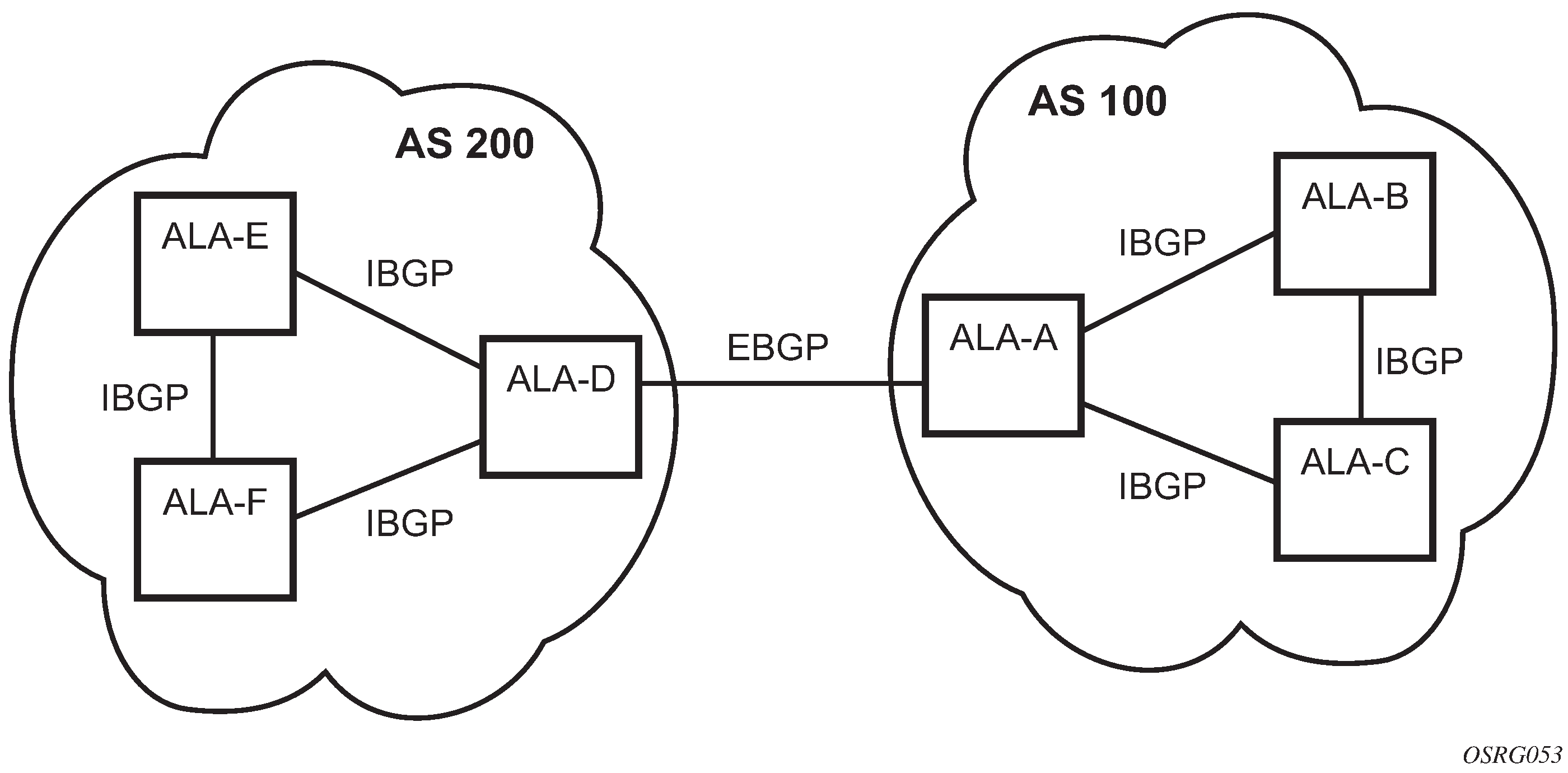A BGP session is a TCP connection formed between two BGP routers over which BGP messages are exchanged. There are three types of BGP sessions: internal BGP (IBGP), external BGP (EBGP), and confederation external BGP (confed-EBGP).
An IBGP session is formed when the two BGP routers belong to the same Autonomous System. Routes received from an IBGP peer are not advertised to other IBGP peers unless the router is a route reflector. The two routers that form an IBGP session are usually not directly connected. Figure: BGP sessions shows an example of two Autonomous Systems that use BGP to exchange routes. In this example the router ALA-A forms IBGP sessions with ALA-B and ALA-C.
An EBGP session is formed when the two BGP routers belong to different Autonomous Systems. Routes received from an EBGP peer can be advertised to any other peer. The two routers that form an EBGP session are often directly connected but multi-hop EBGP sessions are also possible. When a route is advertised to an EBGP peer the Autonomous System number(s) of the advertising router are added to the AS Path attribute. In the example of Figure: BGP sessions the router ALA-A forms an EBGP session with ALA-D.

A confederation EBGP session is formed when the two BGP routers belong to different member AS of the same confederation. More details about BGP confederations are provided in the section titled BGP confederations.
SR OS supports both statically configured and dynamic (unconfigured) BGP sessions. Dynamic sessions are supported by configuring one or more prefix commands in the dynamic-neighbor>match CLI context of a BGP group. Statically configured BGP sessions are configured using the neighbor command. This command accepts either an IPv4 or IPv6 address, which allows the session transport to be IPv4 or IPv6. By default, the router is the active side of TCP connections to statically configured remote peers, meaning that as soon as a session leaves the Idle state, the router attempts to set up an outgoing TCP connection to the remote neighbor in addition to listening on TCP port 179 for an incoming connection from the peer. If required, a statically configured BGP session can be configured for passive mode so that the router only listens for an incoming connection and does not attempt to set up the outgoing connection. The router always operates in passive mode with respect to its dynamic (unconfigured) sessions.
The source IP address used to set up the TCP connection to the statically configured or dynamic peer can be configured explicitly using the local-address command. If a local-address is not configured then the source IP address is determined as follows:
if the neighbor’s IP address belongs to a local subnet the source IP address is this router’s IP address on that subnet
if the neighbor’s IP address does not belong to a local subnet the source IP address is this router’s system IP address
In addition, it is possible to configure the local address with the name of the router interface. To configure the BGP local address to use the router interface’s IP address information, the local-address command is used in conjunction with the router interface name (ip-int-name) parameter.
Configuring the router interface as the local address is available in both the config>router>bgp>group context and the config>router>bgp>group-neighbor context.
When the router interface is configured as the local address, BGP inherits the address from the interface as follows:
BGPv4 sessions
The primary IPv4 address configured on the interface is used as the local address.
BGPv6 sessions
The primary IPv6 address configured on the interface is used as the local address.
If the corresponding IPv4 or IPv6 address is not configured on the router interface, the BGP sessions that have this interface set as the local address are kept down until an interface address is configured on the router interface.
If the primary IPv4 or IPv6 address is changed on the router interface and that interface is being used as the local address for BGP, then BGP bounces the link. This removes all routes advertised using the previous address and start advertising those routes again using the newly configured IP address.